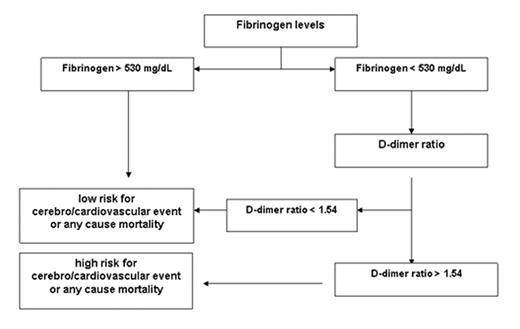Abstract
Introduction: The coagulation system plays a pivotal role in the creation and development of vascular clotting. It is activated during infection episodes, as can be measured by different markers like, d-dimer, plasminogen activator inhibitor-1 (PAI1) and fibrinogen. The goal of this study was to check whether high levels of d-dimer, fibrinogen or PAI1 during acute infection, as markers of the coagulation system, indicates higher risk for cerebro-cardiovascular disease or any cause mortality in elderly during 6 months after the infection episode.
Methods: Coagulation markers, d-dimer, fibrinogen and PAI1 levels as well as other routine demographic and laboratory variables were recorded in elderly patients hospitalized due to infections. The variables were recorded at the time of admission, at discharge and at 6 months after discharge. End points of the study were Cerebro vascular events, acute coronary syndrome, other thromboembolic events and all cause mortality.
Results: The study group consisted of 52 patients, 5 of them died during hospitalization, 4 died later from infectious complications and 6 had a cerebrovascular or cardiovascular (CCV) event. Lower fibrinogen levels were associated with development of CCV events. A statistically significant difference (p=0.048) was found between fibrinogen levels at time of discharge from the hospital among patients with CCV event (366±149 mg/dL) compared to the levels among patients without CCV event (511±139 mg/dL), though comparing fibrinogen levels at admission did not reach statistical significance (patients with CCV event −456±70 mg/dL, patients without CCV event −544±133 mg/dL, p=0.052). Furthermore, the ratio of d-dimer levels measured in admission to the levels at discharge was found to be significantly higher (p=0.029) in patients that eventually had CCV event (1.60±0.5) compared to patients who did not have CCV event (1.12±0.4). PAI-1, Platelets or other Blood variables were not significantly different between the groups. Based on these differences an algorithm was build to identify patients with infection in high risk for CCV event (figure). Patients with fibrinogen levels on admission below 530 mg/dL and d-dimer ratio above 1.54 were identified to be at high risk for CCV event. The algorithm yielded a sensitivity and specificity of 66% and 95%, respectively. The hazard ratio for these patients was found to be 16.8 (95% confidence interval: 3.06–92).
Conclusions: In this study we found that lower levels of fibrinogen are associated with higher risk for developing a CCV event, while the opposite occurs for d-dimer ratio. An algorithm was developed for identification of high risk patients. Further research is needed to validate these results in order to identify a group of people that might benefit from long term antithrombotic agents in order to prevent cardio and cerebro-vascular events.
Author notes
Disclosure: No relevant conflicts of interest to declare.


This feature is available to Subscribers Only
Sign In or Create an Account Close Modal